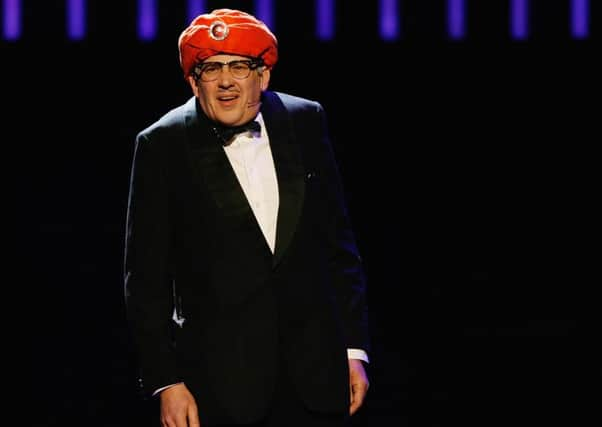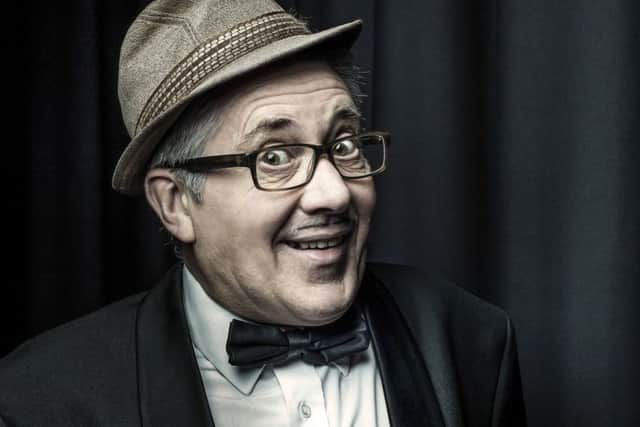Count Arthur Strong - how Leeds helped shape a TV comedy creation


Or, as his friends and family prefer to call him, Steve Delaney. Bumbling, pompous, arrogant and vaguely deluded, Count Arthur is a an actor who seldom finds any gainful employment, and who rails against the injustices of the world in an incoherent jumble of malapropisms and observation.
He is Steve’s creation and he’s loosely based on several people he knew when he was growing up in Leeds as a lad, and when he first started work in the city’s theatres.
Advertisement
Hide AdAdvertisement
Hide Ad

Today, Steve lives in rural Somerset, a long way away from the inner-city environment in which he was raised. Born in 1954, Steve recalls that he had “a very happy childhood. Happy in the sense that it was perfectly normal, I walked out the front door – we lived in Harehills, in a road that has since been demolished – and straight on to the street. I met my mates, we played football on the cobbles, and I went back in for my tea. Very ordinary, the telly was always on in the kitchen.”
And it was black and white in those days. “Young people today cannot believe that TV and films all used to be in black and white, and I have heard it said that any decent movie has to be in colour! A daft idea. But, anyway, very early on I wanted to be on that TV thing. Underneath it all was me wanting to be an actor, but the main goal was being on screen.”
Advertisement
Hide AdAdvertisement
Hide AdAt the bottom of the road where his family lived was a Working Men’s Club, where his mum and dad liked to go. His father was a foundryman and his mother was a seamstress, so there was always food on the table. “They’d come back and tell me about the people that they’d seen on the stage of the club, and there were a lot of big names back then, who were slipping back down the ladder.”
Next door lived an old woman who had a son Willie, or Billy, Kay, who chief electrician at Leeds Grand Theatre. “Mrs Kay was not too steady on her feet so I’d be told to go and get her shopping for her, and to carry the heavy bags home, so Uncle Willie would reward me with tickets to things like the pantomime. The first one I saw, and I remember it vividly, was Cinderella, and Lonnie Donegan was playing Buttons. What Uncle Willie did do, so happily for me, was to introduce me to live performance in a theatre.”
Steve was drawn to character-led comedy. “There was Tony Hancock, of course, and then Steptoe and Son. Galton and Simpson were the best writers ever. They could do humour brilliantly, but interwoven with that was pathos, honesty, and a keen eye for individuality. It wasn’t sitcom for sitcom’s sake, they created a reality. Arthur Haynes was another one I loved”.
Advertisement
Hide AdAdvertisement
Hide AdSteve didn’t enjoy school aand left at just 15, “I was a bit rudderless, without a sense of much direction.” He found work in Leeds market and also started to dabble in amateur dramatics and before long he came to the notice of “that remarkable man”, David Morton, who was then the Leeds Education Authority’s Inspector for Drama. “He had the brilliant idea of engaging teenagers in drama classes and workshops in the school holidays. We came from all over. People like me who had an interest but no real direction, others who were off to university in a couple of months, all sorts of backgrounds. He was an inspirational man.” Leaving the markets behind, Steve went to the (then) Jacob Kramer School of Art in the centre of Leeds, and briefly worked as a photographer and a commercial artist. He was still crewing shows at The Grand and then found himself a job as a carpenter at the old Leeds Playhouse and then stage manager with Leeds Theatre in Education.
Leap forward to 1979, and Steve enrolled at the Central School of Speech and Drama. To pull in a few pennies to pay for his upkeep, he did carpentry jobs on the side. He keeps up those skills to this day, and says with a grin: “I can put up a pretty neat set of shelves, if anyone wants anything doing.”
It was while he was at Central that the idea of Count Arthur started. “There was no ‘lightbulb moment’”, Steve insists. “He just started to evolve somehow. His background seemed to slowly form together. He was brought up in Doncaster – he wasn’t born there, he was evacuated – and he had an Auntie Irene who used to talk to lamps.” Sorry, talk to lamps? “Yes, you know, she’d chat to them. People do talk to things. For her, it was lamps. But maybe it was something else? Count Arthur is always changing his recollections to meet new situations.”
Count Arthur seems to live in an alternative universe. “But there are people like him”, Steve insists. “People who invent a story in which they play a big part, something that has happened to them gets embroidered. The imagination, and the invention, takes over. Count Arthur might have seen the film Bridge on the River Kwai. Then he slowly convinces himself that he might have had a role in it. Then he definitely played a part. And then, who knows, he’ll be telling you that he was actually there, in person, during the war. Same as his phoney title. He may have met the Queen Mother one time in a line-up after a performance, and then she’ll be one of his best mates, and bestowed the ‘Count’ on him. In his mind, he believes it all.”
Advertisement
Hide AdAdvertisement
Hide AdThe character is grounded in truth. “I don’t go out specifically listening to people, and eavesdropping”, he explains, “but I do often, and generally quite unexpectedly, overhear something that gets woven in to the show. Tours like the one I’m just starting take about half a year to pull together, and that’s all done in my office at the bottom of the garden, where I work on my laptop.
“Then I rehearse it to myself, out loud. When the tour starts, I’m still running through it as I drive to gigs, I sit in the car as I’m going along, and I talk it all through. Just me. Alone.”
After Central, Steve worked on dozens of TV plays and series. He’s been in everything from All Creatures Great and Small to The Bill, from Casualty to Agatha Christie’s Poirot. Count Arthur “lurked in the background”. Then, in 1997, the ersatz nobleman was resurrected at the Edinburgh Festival, on the Fringe. Steve recalls that he’d drum up audiences by “going out on to the Royal Mile, as Count Arthur, and haranguing complete strangers, in the hope that they’d be interested enough to buy a ticket for the complete show. If I got thirty people in, I was extremely happy.”
He went back to Edinburgh for several years. Then in 2005 came seven yearly series of him own BBC Radio 4 show, and later still his own TV series, which was a big success and now he’s back with a new tour, Is there Anybody Out There?
Advertisement
Hide AdAdvertisement
Hide AdThe Count will, says Steve, “be looking at subjects as varied as the infinite variety of the universe and the price of a packet of broken biscuits. I want the audiences to be about twenty minutes in, and thinking ‘Hold on a second, how on earth did we get to here?’” laughs Steve. “It’s a glorious ramble, unwinding through a stream of barmy unconsciousness..”
How much is him and how much is Count Arthur? “Quite a lot of both in each, I think. I have to have about an hour to myself in my dressing room before every performance, so that I can get my thoughts together, and then, just before the show starts, I get a couple of moments of blind panic, and then...I’m off. I haven’t done any other acting since Count Arthur arrived at my doorstep. And I have to say, once again, ‘thank you, Uncle Billy, and the lovely people of Leeds’. If it hadn’t been for you...”
The Count comes to Yorkshire
It was at the Edinburgh Fringe where Count Arthur Strong slowly gained a cult following. In the early days Delaney went out on Royal Mile as Count Arthur in an effort to get people to go to his show. “If I got thirty people in, I was extremely happy.”
Count Arthur Strong’s Is There Anybody Out There? Tour plays several Yorkshire dates over the coming months:
Advertisement
Hide AdAdvertisement
Hide AdSheffield Lyceum on September 17; Ilkley King’s Hall on September 19; Huddersfield Lawrence Batley Theatre on October 16; Harrogate Theatre on October 18; Scarborough Spa Theatre on October 24; York Barbican on October 25; and in 2020 Cast in Doncaster on February 6, and Bridlington Spa Theatre on February 29.